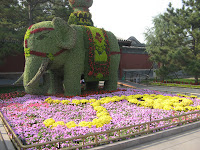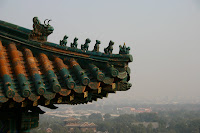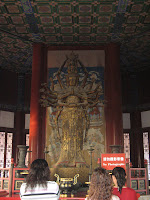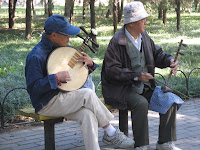The Summer Palace
The Summer Palace was built in 1750 and was an imperial garden and the temporary palace of the royal family in the Qing Dynasty. In 1860 the garden was burnt down by the Anglo-French forces and rebuilt in 1888. The Summer Palace covers an area of over 740 acres (of which 75% is covered by water - Kunming Lake). The most notable structures of The Summer Palace are found near the east gate and on Longevity Hill. However, the rest of the grounds are strewn with temples, beautiful gardens, relics and pavilions. We had an enjoyable afternoon exploring the Summer Palace and got to climb lots of stairs to get to the temple, hall and pavilion on Longevity Hill.
Summer Palace - East gate entrance with beautiful flower displays.




Summer Palace - Hall of Benevolence and Longevity
The hall of Benevolence and Longevity is the main building of The Summer Palace. There is a large courtyard at the front this building with bronze animals (including the mythical qilin, a hybrid animal that only appeared on earth at times of harmony) and different types of relics on display. The building itself houses a hardwood throne, which is unfortunately off limits to the public.
The hall of Benevolence and Longevity is the main building of The Summer Palace. There is a large courtyard at the front this building with bronze animals (including the mythical qilin, a hybrid animal that only appeared on earth at times of harmony) and different types of relics on display. The building itself houses a hardwood throne, which is unfortunately off limits to the public.




Summer Palace - Gardens and Pavilions



Summer Palace - The Long Corridor
The Long Corridor is situated along Kunming Lake's north shore at the foothills of Longevity Hill. It extends from the Yaoyue gate in the east to the Shizhang Pavilion in the west. It covers a distance of 728 metres and has 273 sections. Of all the corridors in classical Chinese gardens, this is the longest. What makes this corridor so beautiful, are the over 8000 colourful painting on the beams of birds, flowers and landscapes.
The Long Corridor is situated along Kunming Lake's north shore at the foothills of Longevity Hill. It extends from the Yaoyue gate in the east to the Shizhang Pavilion in the west. It covers a distance of 728 metres and has 273 sections. Of all the corridors in classical Chinese gardens, this is the longest. What makes this corridor so beautiful, are the over 8000 colourful painting on the beams of birds, flowers and landscapes.









Summer Palace - Kunming Lake




Summer Palace - Longevity Hill
Longevity Hill is situated on the north shore of Kunming Lake. Perched on Longevity Hill is the Buddhist Fragrance Pavilion and Cloud Dispelling Hall, which are both interconnected by corridors and at the crest sits the Buddhist Temple of the Sea of Wisdom. We climbed to the very top to see temple and got some views of Kunming Lake and the Summer Palace (unfortunately it was a little hazy that day).
Longevity Hill is situated on the north shore of Kunming Lake. Perched on Longevity Hill is the Buddhist Fragrance Pavilion and Cloud Dispelling Hall, which are both interconnected by corridors and at the crest sits the Buddhist Temple of the Sea of Wisdom. We climbed to the very top to see temple and got some views of Kunming Lake and the Summer Palace (unfortunately it was a little hazy that day).






















Summer Palace - View of Kunming Lake and The Summer Palace from the top of Longevity Hill



Summer Palace - Empress Dowager Cixi's extravagant boat made from marble on Kunming Lake.





Temple of Heaven Park
The Temple of Heaven Park covers an area of 660 acres and comprises a complex of halls and a park. The complex was used by the emperors of the Ming and Qing dynasties, for ceremonies of prayer to the Heavens for good harvests. The Temple of Heaven's design has much significance with a constant reference to heaven and earth - seen from above the temples are round and the bases are square, a pattern derived from ancient Chinese belief that heaven is round and the earth is square. The Temple of Heaven is enclosed with a large wall. The northern part of the wall is semi-circular symblizing the heavens, while the south part of the gate is square, symbolising earth. All the buildings within the temple have dark blue roof tiles, again representing heaven.
The park itself is huge and beautiful with many old Cypress trees. The park surrounds the complex of halls and is an important meeting place for the locals, especially the elderly. We made sure we got there early one morning to watch all the activities in the park. It was refreshing to see many elderly people in the park practicing their water calligraphy, doing tai chi, exercising, dancing, playing instruments, reading poetry, singing and playing games (there were even a few people hugging trees - we still haven't quite figured this one out yet, but it would appear they were praying or meditating). The best part is that this is an everyday event and it was so heartwarming and uplifting to see the sense of community and belonging that exists for these elderly people.
The Temple of Heaven Park covers an area of 660 acres and comprises a complex of halls and a park. The complex was used by the emperors of the Ming and Qing dynasties, for ceremonies of prayer to the Heavens for good harvests. The Temple of Heaven's design has much significance with a constant reference to heaven and earth - seen from above the temples are round and the bases are square, a pattern derived from ancient Chinese belief that heaven is round and the earth is square. The Temple of Heaven is enclosed with a large wall. The northern part of the wall is semi-circular symblizing the heavens, while the south part of the gate is square, symbolising earth. All the buildings within the temple have dark blue roof tiles, again representing heaven.
The park itself is huge and beautiful with many old Cypress trees. The park surrounds the complex of halls and is an important meeting place for the locals, especially the elderly. We made sure we got there early one morning to watch all the activities in the park. It was refreshing to see many elderly people in the park practicing their water calligraphy, doing tai chi, exercising, dancing, playing instruments, reading poetry, singing and playing games (there were even a few people hugging trees - we still haven't quite figured this one out yet, but it would appear they were praying or meditating). The best part is that this is an everyday event and it was so heartwarming and uplifting to see the sense of community and belonging that exists for these elderly people.

























Temple of Heaven - Entrance to the complex of halls
We entered the Temple of Heaven from the south entrance of the park and made our way to each of the halls.
We entered the Temple of Heaven from the south entrance of the park and made our way to each of the halls.




Temple of Heaven - Round Altar
The Round Altar is where the prayers and sacrificial rituals took place.
The Round Altar is where the prayers and sacrificial rituals took place.


Temple of Heaven - Echo wall and Imperial Vault of Heaven
The Echo Wall which surrounds the Imperial Vault of Heaven is situated north of the Round Altar. The Echo Wall has a diameter of 65 metres and has unusul acoustic properties that allows sounds to be transmitted over large distancees. The Imperial Vault of Heaven was built at the same time as the Round Altar and used to contain spirit tablets used in the winter solstice ceremony
The Echo Wall which surrounds the Imperial Vault of Heaven is situated north of the Round Altar. The Echo Wall has a diameter of 65 metres and has unusul acoustic properties that allows sounds to be transmitted over large distancees. The Imperial Vault of Heaven was built at the same time as the Round Altar and used to contain spirit tablets used in the winter solstice ceremony




Temple of Heaven - Hall of Prayer for Good Harvests
The Hall of Prayer for Good Harvests is the crowning structure of the whole complex and stands magnificently on a three-tiered marble terrace. It is the perfect example of Ming architecture. This temple was rebuilt in 1890 after it was burnt down. When rebuilding took place, China's forests lacked timber strong enough to uphold the heavy tiled roof. It was then decided that pine logs from the forests of Oregon would be used. These pillars are still standing today - the four central ones symbolize the seasons, the twelve in the next ring symbolize the months of the year and the twelve outer ones represent the twelve tranditional Chinese hours. The most amazing thing is that the wooden pillars ingeniously support the ceiling without nails or cement. This is a huge accomplishment for a building that stands 38 metres high and is 30 metres in diameter. It is not surprising that the Temple of Heaven is a UNESCO World Heritage site.






Temple of Heaven - The north gate where we exited the park




Lama Temple
The Lama Temple is Beijing's most magnificent Buddhist temple. This temple was once the residence of Count Yin Zhen, who in 1723 became emperor and moved to The Forbidden City. In 1744 it was converted to a lamasery and became home to many monks from Mongolia and Tibet. The Lama Temple consists of 5 main halls, each one taller than the preceding one. Each hall has a different Buddhu, with the final hall, Wanfu Pavillion holding a stupendous 18 metre high statue of the Maitreya Buddha. This Buddha has been authenticated by Guiness World Book of Records, as being carved out of a single white Sandalwood tree 26 metres high. Needless to say, this carved Buddha statue was very impressive.
The Lama Temple is Beijing's most magnificent Buddhist temple. This temple was once the residence of Count Yin Zhen, who in 1723 became emperor and moved to The Forbidden City. In 1744 it was converted to a lamasery and became home to many monks from Mongolia and Tibet. The Lama Temple consists of 5 main halls, each one taller than the preceding one. Each hall has a different Buddhu, with the final hall, Wanfu Pavillion holding a stupendous 18 metre high statue of the Maitreya Buddha. This Buddha has been authenticated by Guiness World Book of Records, as being carved out of a single white Sandalwood tree 26 metres high. Needless to say, this carved Buddha statue was very impressive.






















No comments:
Post a Comment